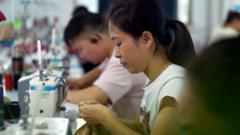In the bustling district of Panyu, Guangzhou, the sound of sewing machines serves as a stark reminder of the hidden costs behind Shein's success, the world's largest fast fashion retailer. With its inventory catering to a demanding global customer base, Panyu has earned the moniker "Shein village," where workers toil tirelessly, often exceeding 75 hours a week in violation of Chinese labor laws.
Despite touting itself as committed to fair treatment within its supply chain, Shein's rise to a £54bn ($66bn) valuation and potential IPO has been marred by allegations of labor exploitation and forced worker issues, including child labor. Observations and reports depict a landscape where underpaid workers labor in a grueling cycle to meet fast-paced production demands.
Factory workers revealed that they commonly work 10 to 12 hours a day, with just one day off monthly. Earnings are low, with many only making a pittance—less than a dollar for a simple t-shirt. The high living costs in the area compel workers to seek additional contracts, further entrenching their need for steady income.
The working conditions depict a broader issue within the fashion supply chain, with the average pay falling below the "living wage" standard set by various advocacy groups. Experts highlight that such labor practices are exploitation and call for greater visibility regarding labor standards and conditions in the industry.
As scrutiny grows from international observers and human rights groups, Shein's sourcing of cotton from regions like Xinjiang, associated with allegations of forced labor, complicates its public image. Calls for transparency in supply chain management intensify as ethical concerns surge.
Factory owners echo the duality of Shein's influence—consistently large orders can stabilize income, but the pressure to lower production costs often undermines worker compensation and ethical practices. For many manufacturers in the region, Shein has transformed the commercial landscape, shaping operational models in ways that challenge traditional production methods.
Despite the arduous conditions, some workers still express pride in their contributions to the global market, highlighting a complex relationship between economic necessity and employment conditions. The lights in factories often remain on late into the night, with workers continuing to forge garments for impatient markets in cities worldwide, continuously searching for their next bargain.
In examining Shein's environment, one thing becomes clear: the cost of fast fashion extends beyond mere price tags; it embodies a tapestry of human effort, sacrifice, and the quest for dignity amid an exploitative industry.



















